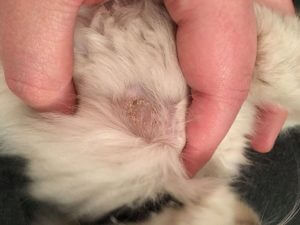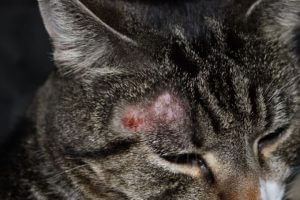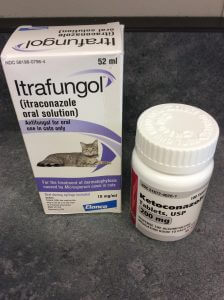Contrary to its name, a ringworm is not actually a worm; it is a fungus. It is the most common dermatophyte or fungus that requires keratin for growth. The fungus lives and grows in the hair follicles, the outermost layer of the skin, and sometimes nail beds. The three most common species of ringworm are Microsporum gypseum, Microsporum canis, and Trichophyton mentagrophytes. It is found all around the world in dogs, cats, humans, and many other animal species.
Ringworm spores are spread through direct contact and indirectly on contaminated objects. A host can carry the spores without showing symptoms of the disease. The spores can live in the environment for up to 18 months.
The immune system of a healthy individual can usually fight off a ringworm infection. Juveniles, seniors, and immunocompromised patients are more commonly affected. Animals who commune with multiple other animals (multi-cat households, daycares, etc.) or those in unsanitary conditions (strays, rescues, hoarding situations, etc.) have an increased likelihood of transmitting ringworm. Warm and/or humid environments often promote the growth of fungus-like conditions.
Symptoms:
Ringworm is highly contagious and easily transmitted. Though not a life-threatening disease, it is quite an annoyance. Ringworm is zoonotic, which means pets and people can pass it between each other. Cats can often be carriers that show no symptoms. Symptoms include:


- Circular areas of hair loss
- Inflamed, red, scabby rashes
- Usually not itchy
- Dull, dry fur with brittle hair
- Rough, brittle claws
Diagnosis:
A diagnosis can be made by your veterinarian based on your pet’s symptoms and history of possible exposure, though confirmation would likely be needed via fungal culture. A sample of hair and skin cells from lesions would be cultured (grown in a controlled environment) and analyzed under a microscope. The species of ringworm can be identified by the specific microscopic characteristics of the fungal spores.
A Woods Lamp (ultraviolet light) is sometimes used to detect ringworm since it glows under this specific light. Though it is not 100% reliable since many other materials glow as well.
Treatment:

Treatment should be determined by your veterinarian, based on the patient and severity of infection. Topical antifungals are most commonly prescribed which may include creams, ointments, and frequent medicated baths. Oral antifungals may also be prescribed. Treatment may last for many months. Decontaminating the environment is extremely important to prevent reinfection and transmission to others. A 10% bleach solution is generally recommended for cleaning the household and any items the patient comes in contact with. Regular vacuuming to remove excess hair and dander is strongly recommended.
There are many at-home remedies you can find on the internet. Be aware that not every remedy is safe for pets (example: tea tree oil, bleach, etc.). Please do not treat your pet at home without consulting your veterinarian first.
Prevention:
When acquiring a new pet, it is recommended to have them checked by your veterinarian before introducing them to the household. If the new pet is suspected of having any infectious diseases, it may be suggested to quarantine them away from other pets.
Hygiene is very important when working with possible ringworm suspects. Wash your hands thoroughly and change your clothing before coming in contact with other pets. Wash any bedding or fabrics regularly in hot water. Clean any grooming tools, bowls, toys, etc with a 10% bleach solution.
If you are acquiring a new pet or see these symptoms in your current pet(s), give us a call to schedule an appointment. The knowledgeable team at Bemidji Veterinary Hospital can help determine the best course of action. Call us today at (218) 751-2753.
What's Next
Call us or schedule an appointment online.
Meet with a doctor for an initial exam.
Put a plan together for your pet.


